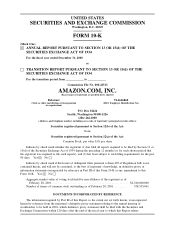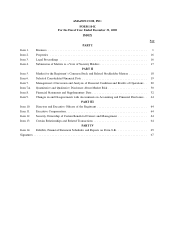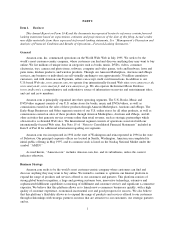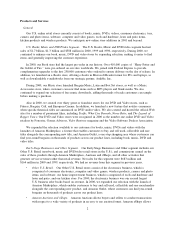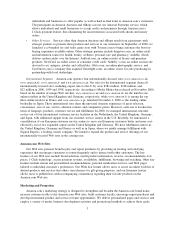Amazon.com 2000 Annual Report Download - page 17
Download and view the complete annual report
Please find page 17 of the 2000 Amazon.com annual report below. You can navigate through the pages in the report by either clicking on the pages listed below, or by using the keyword search tool below to find specific information within the annual report.•longer payment cycles,
•consumer protection laws and restrictions on pricing or discounts,
•lower level of adoption or use of the Internet and other technologies vital to our business, and the
lack of appropriate infrastructure to support widespread Internet usage,
•lower level of credit card usage and increased payment risk,
•difficulty in developing employees and simultaneously managing a larger number of unique foreign
operations as a result of distance, language and cultural differences,
•laws and policies of the U.S. affecting trade, foreign investment and loans, and
•tax and other laws.
As the international e-commerce market segments continue to grow, competition will likely intensify.
Local companies may have a substantial competitive advantage because of their greater understanding of, and
focus on, the local customer, as well as their more established local brand name recognition. In addition,
governments in foreign jurisdictions may regulate e-commerce or other online services in such areas as content,
privacy, network security, copyright, encryption or distribution. We may not be able to hire, train, retain,
motivate and manage required personnel, which may limit our growth in international market segments.
Our Strategic Partner Program Subjects Us to a Number of Risks
Beginning in the fall of 1999, we entered into agreements with selected companies that involved the sale
of products and services by these companies on co-branded sections of the Amazon.com Web site and other
promotional services, such as advertising placements and customer referrals. In exchange for the services we
provide under these agreements, we receive cash, equity securities of these companies, or a combination of the
two. In some cases, we have also made separate investments in a strategic partner by making a cash payment in
exchange for equity securities of that partner. As part of this program, we may in the future enter into
additional agreements with existing strategic partners or new ones and may also make additional investments.
To the extent we have received equity securities as compensation, fluctuations in the value of such securities
will impact our ultimate realization of cash value either positively or negatively.
At December 31, 2000, we hold several investments in third parties, primarily investments in our strategic
partners, that are accounted for using the equity method. Under the equity method, we are required to record
our ownership percentage of the income or loss of these companies as being income or loss for us. We record
these amounts generally one month in arrears for private companies and three months in arrears for public
companies. One of our strategic partners, drugstore.com, is a public company and four others are private
companies. The companies in which we have equity method investments are engaged in the Internet and
e-commerce industries, are likely to experience large losses for the foreseeable future and may or may not be
ultimately successful. While the future losses we will record under the equity method are limited to the amount
of our investment, we expect to record additional equity method losses in the future. Our investments in equity
securities that are not accounted for under the equity method are included in ‘‘Marketable securities’’ and
‘‘Other equity investments’’ on our balance sheet.
We regularly review all of our investments in public and private companies for other-than-temporary
declines in fair value. When we determine that the decline in fair value of an investment below our accounting
basis is other-than-temporary, we reduce the carrying value of the securities we hold and record a loss in the
amount of any such decline. During the third and fourth quarters of 2000, we determined that the declines in
value of six of our investments in our strategic partners were other-than-temporary, and we recognized losses
totaling $189 million (consisting of $34 million and $155 million in the third and fourth quarters of 2000,
respectively) to record these investments at their then current fair value. One of our strategic partners in which
we also had an investment, living.com, declared bankruptcy during 2000, and another of our investments,
Pets.com, voluntarily liquidated in January of 2001.
9


